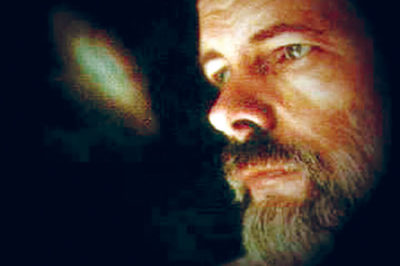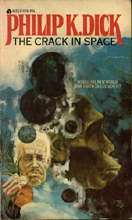This article was published in New Dawn 74 (Sept-Oct 2002)
It seems hard to imagine that it has been nearly twenty years since Bladerunner was released. That riveting and influential film was the first movie to be inspired by the writings of science-fiction author, Philip K. Dick. Other films, of varying success, have followed, including Total Recall and Screamers, but the until now the most Dickian movies have been those that copped his dystopian and paranoid sensibility without directly basing themselves on one of his books or short stories. The Truman Show, They Live!,Pleasantville, and most notably, The Matrix, were all Dick films at heart, despite his absence from their credits.
The recently released Spielberg film, Minority Report, returns to directly dipping from PKD’s deep well of inspiration, and despite the inevitably Spielbergian ending, succeeds in evoking one of Dick’s favourite themes: how does one elude the suffocation of an encroaching police state? In Minority Report, this trope takes the form of the local Department of Precrime in Washington D.C., which has succeeded in eliminating murders by arresting and incarcerating the perpetrators before they commit their crimes. This is accomplished by drawing on the abilities of three precogs (for precognitives), who have the involuntary talent of seeing into the near future and glimpsing the murders-to-be in progress. As the film unfolds, in the year 2054, a national referendum is about to occur on whether to expand precrime prevention to a national policy.
Given the recent moves by the Bush Administration in the US to indefinitely detain those who have committed no crimes, but who may have planned to, the timeliness of Minority Report is almost uncanny. Dick’s original short story appeared in 1956, and the script for the film was written well in advance of the shock of 9/11. But somehow, Dick’s intuitions of precrime enforcement have been brought to the big screen at just the moment when their analog is being enacted in real life. PKD, who died in 1982, would savour the irony, were he still with us.
Gnosis
Gnosticism is a name commonly applied to numerous early Christian sects who emphasised the necessity of receiving “gnosis” (divine knowledge of true reality) in order to be saved. While they considered themselves to be Christian, the Gnostics diverged from both Judaism and Catholic Christianity in their belief that this world was a flawed and ensnaring creation of a despotic Demiurge who had usurped the position of God. Through the agency of a redeemer Christ and his bride, Sophia (Wisdom), the Gnostics hoped to return, upon death, to the most high realm of the Pleroma (Fullness) to unite with the true Unknown God.
That, at least, is the standard potted summary of Gnosticism. If one takes a broader view, there have been many gnosticisms, and many “gnosi” – some predating the Christian Era and some quite independent of Christianity. Gnosis, as a synonym for illumination or mystical union, is equivalent to marifah(Arabic) or irfan (Persian) in esoteric Islam, for example. However, while we might assume that the state of consciousness signified by the term “gnosis” is universally accessible (or at least potentially so), it is not at all certain that those using the term were always referring to the same thing.
For instance, the gnosis of the Sufi mystics of Islam includes no admission of the existence of a Demiurge or false, lower God. Indeed, tawhid, the Unity of God and Creation, is such a fundamental assumption of Islam, that a spiritual realisation pointing to a Higher God than that of the Creator would be immediately rejected as a delusion. On the other hand, Hindu yogis might readily agree with many Gnostics that this world is a veil or delusion (maya in Sanskrit), and that there is an Absolute God behind or above lesser gods. But few yogis would share the Gnostic assessment that this indicates a moral flaw in the universe.
What exactly is the nature of the divine knowledge that the Gnostics and other mystics have sought? It is impossible to describe precisely, because of the non-discursive nature of that knowledge. Frithjof Schuon refers to gnosis as “our participation in the ‘perspective’ of the divine Subject which, in turn, is beyond the separative polarity, ‘subject-object’….”3 G.E.H. Palmer refers to it as “Wisdom made up of Knowledge and Sanctity,” and underscores the distinction “between knowledge acquired by the ordinary discursive mind and the higher Knowledge which comes of intuition by the Intellect, the term Intellect having the same sense as in Plotinus or Eckhart.”4
In other words, gnosis, according to this definition, is an experiential “knowing” that results from the expansion of the Gnostic’s consciousness to the level of the divine Intellect, where the illusion of the separate self (ego) is obliterated – at least temporarily – in the vast perspective of the higher Self. Such a state cannot, of course, be sustained indefinitely. What goes up must come down. But having risen to such heights, the ego that is reassembled upon its descent, is permanently affected. It now “knows” its own place in the cosmic scheme of things.
Such “knowledge” is not easily communicated to others, in part because shared reference points are few, and because any attempt at describing the experience is bound to diminish and reify it. Thus, those who have been blessed with gnosis have used oblique strategies to impart the ineffable: poetry instead of prose; myths instead of clear-cut analysis; paradoxical statements instead of declarations.
There is still another factor contributing to the proliferation of gnosi and gnosticisms: while the experience of gnosis may be ahistorical, i.e., beyond time and place, the gnostic himself is obviously not. A Tibetan Buddhist in the recesses of the Himalayas, who takes reincarnation for granted and believes in numerous gods, is not going to clothe his gnosis in the garments of a Muslim Sufi in Andalucia, who believes in one lifetime and one God. And vice versa.
A gnostic whose historical era and cultural milieu is one of war and persecution is likely to have his circumstances seep into his post-gnosis explication of reality. There may still be a higher Reality beyond conflict and violence that he experiences in gnosis, but his mythic version of the journey to the Truth may feature a harsher struggle to get there than would otherwise be the case.
Finally, there is the personality and psychological condition of the gnostic to be considered. Contrary to contemporary holistic assumptions that assume that the combination of a good diet, a good life, and a good attitude are most likely to lead one to higher spiritual consciousness, this is not always so. Higher states may also be triggered by asceticism, psychoactive substances, disciplined practice, or sheer happenstance. True, an absence of cravings and obsessions may make meditative practice easier, but gnosis can also erupt in someone who is by no means a saint. In such a case, his post-gnosis understanding of the Real may well be tinged with his neurotic predisposition.
The Divine Invasion
Which brings us back to Philip K. Dick.
In February, 1974, Dick was living in Fullerton, California, an undistinguished city in Orange County. He’d fled his long-time residency in Northern California out of fear for his life and his sanity. He’d been mixed up in long-time illicit drug use, tax refusal in protest against the Vietnam War, and chronic poverty. In 1971, his previous home in San Rafael, north of San Francisco, had been broken into by persons unknown, his safe blasted open, and things taken. He’d attempted suicide, checked himself into drug rehab in Vancouver, and in 1972 had flown from there to Fullerton.5
By 1974, he’d married his fifth wife, Tessa, and had a new child, Christopher. But most immediately, in February, he’d just had two impacted wisdom teeth removed and was awaiting the delivery of prescribed medicine from the drug store.6
The doorbell rang and Dick answered the door. The delivery girl from the drug store stood before him, wearing a delicate necklace from which hung a golden fish, a symbol of Christ often worn by evangelical Christians.
As Dick later recounted it – possibly in mythologised form – a laser-like pink beam shot from the fish to Dick’s third eye. It had an extraordinary effect:
I suddenly experienced what I later learned is called anamnesis – a Greek word meaning, literally, ‘loss of forgetfulness.’ I remembered who I was and where I was. In an instant, in the twinkling of an eye, it all came back to me. And not only could I remember it but I could see it. The girl was a secret Christian and so was I. We lived in fear of detection by the Romans. We had to communicate in cryptic signs. She had just told me all this, and it was true.7
There was plenty more to follow. For the next year or so, Dick felt his psyche invaded by a “transcendentally rational mind, as if I had been insane all my life, and suddenly had become sane.”8 He experienced hypnagogic visions, auditions, tutelary dreams, and an eight hour all night vision of thousands of coloured graphics resembling “the nonobjective paintings of Kandinsky and Klee.”9
Dick came to nickname the invasive rational mind as VALIS (for Vast Active Living Intelligence System), which became the name of his 1981 novel recounting his mind-boggling experience in fictional form.
Perhaps most significantly, he perceived that “real time had ceased in 70 C.E. with the fall of the temple at Jerusalem. It began again in 1974 C.E. The intervening period was a perfect spurious interpolation aping the creation of the Mind….”10
PKD’s life-long preoccupation with the questions of “what is reality?” and “what is man?” wouldn’t allow him to resolve his 1974 experiences into a single easy explanation. He variously explained them to himself as communications from God or from a satellite orbiting Earth, or most baroquely as psychic invasions courtesy of Soviet Academy of Sciences psychotronic transmitters. They provided fodder for several more novels before his untimely death at age 53 in 1982.
The question might be fairly asked whether Philip K. Dick’s 1974 experiences constituted a form of gnosis. Judging from his many stories and novels, Dick operated throughout his life from a gut feeling that reality, as we commonly perceive it, is a façade. He sensed that there was something morally wrong in a universe where a friend’s innocent cat could walk across the street and be blithely run over by a passing car. His novels returned, time and again, to the theme of the little man caught in the machinations of powers beyond his kin or control. Dick may have nominally been an Episcopalian, but he was constitutionally a gnostic.
But, here’s the paradox: not every gnostic receives complete gnosis. Some Gnostics, such as the Cathars of southern France, recognised this in dividing their members between mere believers and the elect (perfecti), and it is safe to assume that not every perfecti had achieved full mystical awareness.13
The Gnostics taught that there are several planes or spheres between our material world and the purely spiritual realm of the Pleroma, “home” of the Unknown God. These planes were ruled by Archons, and part of the challenge for the Gnostic’s soul, at death, was to navigate past these cosmic authorities without becoming ensnared.
The Gnostic who realised complete gnosis prior to his own death, (an awareness referred to in Sufi terminology as “to die before you die,”) was blessed with the key to safely make that post-death journey. But not every gnosis is complete and some experiences might provide only a partial realisation – perhaps of an intermediate Archonic realm that more resembles our veiled world than it does the Pleroma.
Although incomplete, this Archonic gnosis could still be useful in shedding light on our present predicament – as long as its insights were not taken as the final word or the total picture.
Philip K. Dick’s gnosis, I’d suggest, was of this partial sort: troubling, compelling, ambiguous, and as political as it was spiritual. His predisposition towards paranoia – exacerbated by amphetamine abuse, and the temper of the McCarthy era and the political upheaval of the ’60s – led him to write dozens of novels prior to 1974 that were broadly gnostic in their exploration of hallucinogenic realities, the individual’s struggle with hostile higher authorities, and in their questioning of conventional morality.
Dick’s February-March ’74 gnosis – which he experienced in a dissociated manner as the intrusion of a higher rational mind into his consciousness – came to be understood by him as a revelation of profound political implications. Given his political preoccupations, which were already in place, this is hardly a surprise.
Human history might seem to be an endless series of recurring cycles: power held by the few consolidates itself, corruption ensues, the regime falls and is replaced, and so on. PKD, however, in the thralls of his pink beam gnosis, arrived at an urgently mythic conclusion: real time stopped in 70 C.E., a spurious dream-time was thrust upon us for nineteen centuries, and then, through external intervention, real time was begun again. Beneath the ordinary appearance of our modern world, Dick (and select others) were really early Christians in conflict with the Roman Empire, which was still in power.
Is this really a grand cosmic truth? I think not. Even in the 1970s it had its trivial side, such as Dick’s notion that President Nixon’s resignation after Watergate was an event of cosmic significance.
But in a metaphorical, and even archetypal, manner, PKD’s gnosis did unveil a politico-spiritual reality that is increasingly relevant to us, twenty years after his death. “The Empire never ended,” wrote Dick, and who would argue with that, as we watch the reigning Superpower rattling its sabres at its minions and designated foes. The cultural collossi of the media conglomerates and Hollywood have spun a dreamlike fog that subsumes the past and future into an everlasting present of novelty and distraction. An effort to merely think clearly, free of clichés, cant, and consumables, takes a heroic effort, akin to dodging the Archons at every turn.
Dick thought that 1974 was a turning point – a time when Truth was beginning anew to penetrate the veil of appearances. One wishes that this were really true, but the shock of 9/11 and the subsequent psyops war, lead one to conclude that there is plenty of veiling still in place – perhaps more than ever.
To the degree that it slightly parts the veil, Minority Report imparts a whiff of Philip K. Dick’s political gnosis. Despite all the hypnotic baffling in place, sometimes a liberating signal makes it through. But no movie – and no book – is a substitute for one’s own rendezvous with the Unknown God.
Any genuine gnosis – whether partial or complete, whether political or spiritual – is more valuable than all the words that have been written about it. Above all, stay alert, and when that knock comes at the door, say a quick prayer that it’s the girl with the fish necklace and not the police from the Department of Precrime.
Recommended Reading:
Gospel of Thomas; The Gnostic Gospels by Elaine Pagels.
Footnotes:
1. Summary from Daniel J.H. Levack, PKD: A Philip K. Dick Bibliography (San Francisco, CA: Underwood/Miller, 1981), p. 24.
2. Ibid, p. 53.
3. Frithjof Schuon, Gnosis: Divine Wisdom (Bedfont, Middlesex: Perennial Books, 1990) p. 76.
4. Ibid, G.E.H. Palmer, “Translator’s Forward,” p. 8.
5. For a full account of Dick’s life, see: Larry Sutin, Divine Invasions: A Life of Philip K. Dick (New York, NY: Harmony Books, 1989).
6. Dick’s own account has him eagerly awaiting pain medicine. His wife’s account suggests he was already on codeine and was awaiting medicine for his blood pressure.
7. From “How to Build a Universe that Doesn’t Fall Apart Two Days Later,” published as an introduction to I Hope I Shall Arrive Soon (New York, NY: Doubleday, 1985.)
8. From interview in Charles Platt, Editor, Dream Makers: The Uncommon People Who Write Science Fiction (New York, NY: Berkeley Books, 1980) p. 155.
9. PKD letter to Peter Fitting, June 1974.
10. Philip K. Dick, VALIS (New York, NY: Bantam Books, 1981) p. 228.
11. Levack, p. 70.
12. Ibid, p. 27.
13. Yuri Stoyanov, The Hidden Tradition in Europe (London: Penguin/Arkana, 1994) p. 162.
© New Dawn Magazine and the respective author.
For our reproduction notice, click here.






